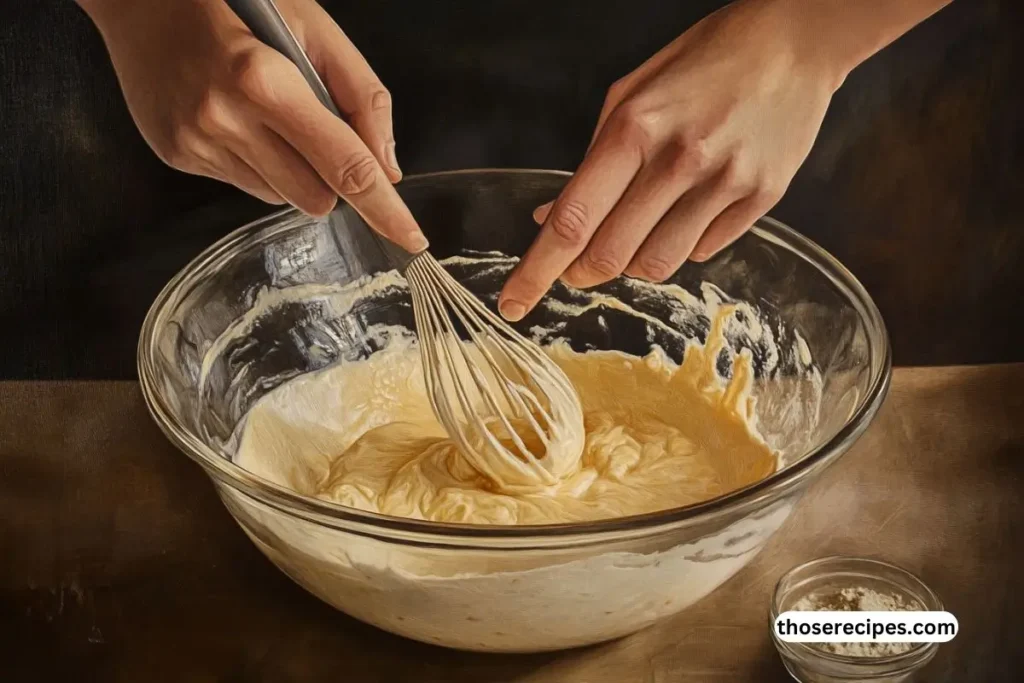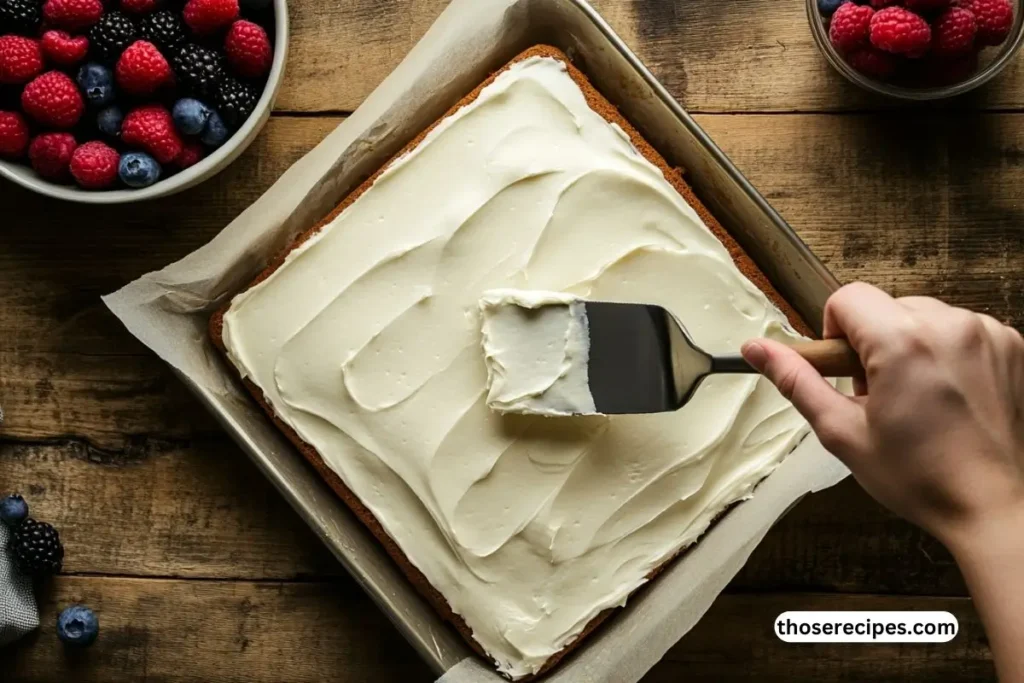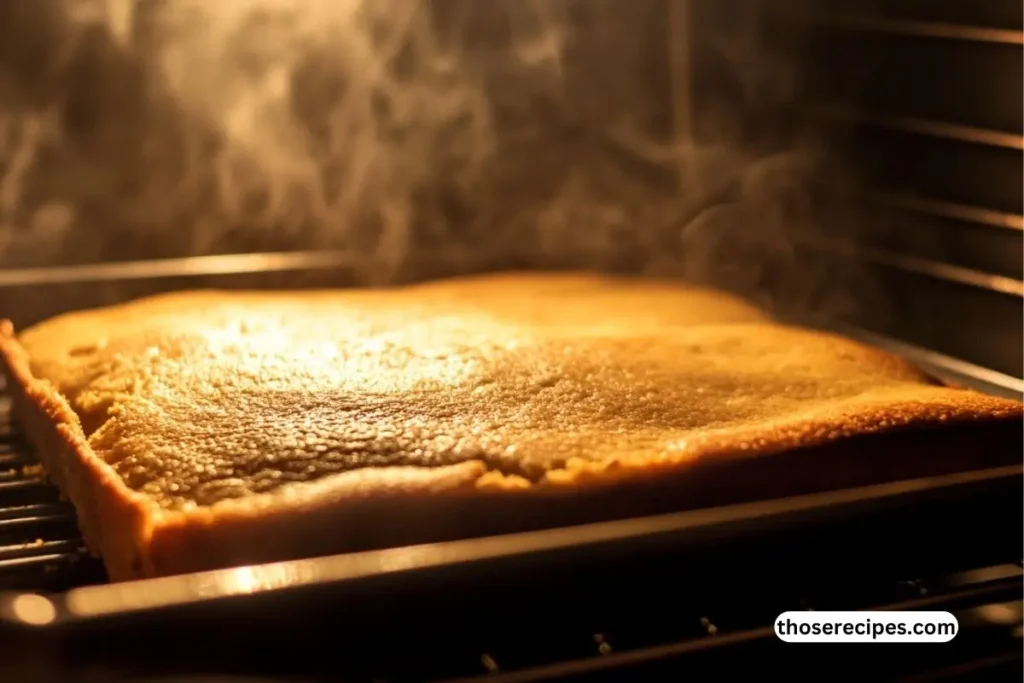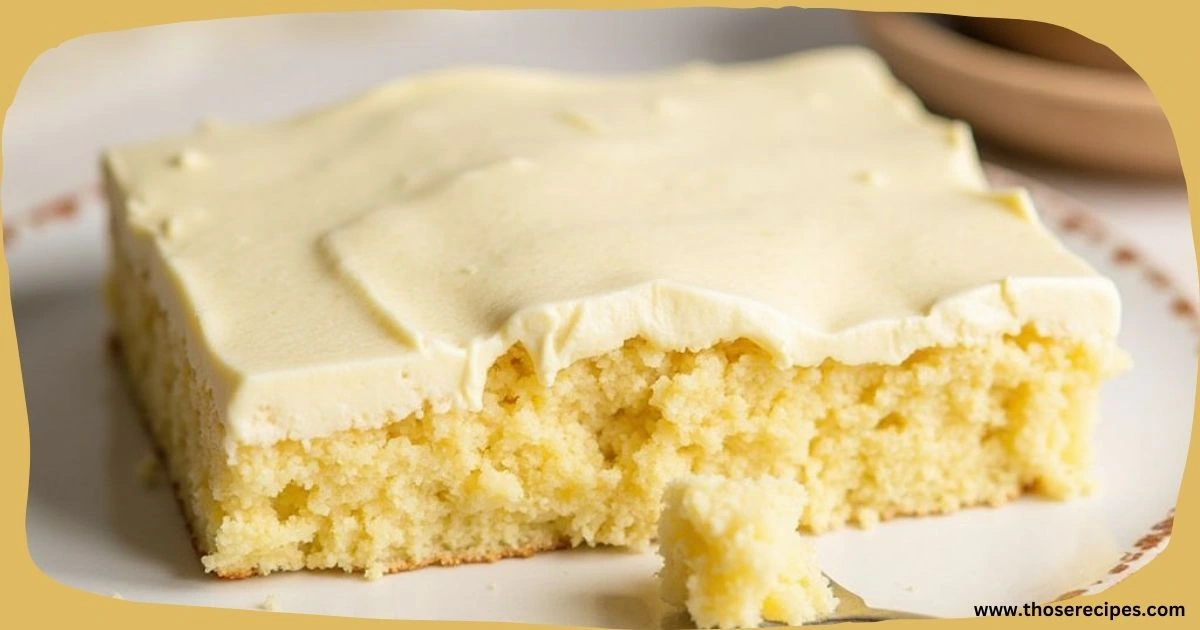Table of Contents
Imagine stepping into your kitchen on a cozy afternoon, the scent of vanilla and warm spices filling the air. You’re about to bake something special—something that’s both comforting and surprisingly unique. As you pour a cup of kefir into the mixing bowl, you might not realize that this simple ingredient has been cherished for centuries, known not only for its health benefits but also for its incredible ability to transform baked goods.
Kefir, a fermented dairy drink rich in probiotics, is the secret weapon behind an ultra-moist and tender cake. Unlike regular milk, kefir enhances flavor, adds a delightful tang, and creates a soft, airy crumb. It’s no wonder bakers around the world have embraced it as a game-changer in cakes, breads, and pastries.
Why You’ll Love This Kefir Sheet Cake
- Effortless & Foolproof – No complicated steps, just simple ingredients and a perfect result.
- Deliciously Moist – The acidity in kefir reacts with baking soda, giving the cake a soft texture.
- Versatile – Keep it simple or dress it up with frosting, fruits, or nuts.
Ready to bake? Let’s dive into the ultimate guide to making a perfect kefir sheet cake! 🍰
What Makes Kefir Sheet Cake So Special?
When it comes to desserts that strike the perfect balance between taste, texture, and simplicity, kefir sheet cake stands out as a remarkable choice. But what exactly makes this cake so unique? The secret lies in the combination of kefir’s culinary magic and the effortless appeal of a sheet cake format. Together, they create a dessert that’s as easy to prepare as it is satisfying to eat.
A Brief Overview of Kefir and Its Benefits in Baking
Kefir, a cultured dairy product made by fermenting milk with live bacterial cultures, has been celebrated for centuries for its probiotic properties. But in baking, it plays an entirely different role—acting as a natural enhancer for texture, flavor, and rise. Unlike regular milk, kefir’s tangy profile and slightly thick consistency make it a perfect partner for sweet recipes, as it balances out the richness with a subtle sharpness.
- Why Kefir Works: The acidity in kefir reacts with baking soda or baking powder, creating a chemical reaction that helps the cake rise. This gives your cake a tender, fluffy crumb.
- Health Benefits: While you indulge, kefir offers a dose of probiotics, calcium, and vitamins—making your dessert a little less guilty.
- Flavor Enhancement: Its fermented nature adds a nuanced depth of flavor that elevates the taste of the entire cake.
Why Choose a Sheet Cake?
Sheet cakes are the unsung heroes of baking—versatile, fuss-free, and ideal for serving a crowd. The flat, rectangular shape offers the perfect canvas for creativity, whether you prefer a minimalist glaze or intricate frosting designs.
- Convenience: With no need for stacking layers or complex decorating techniques, a sheet cake simplifies the process without compromising on presentation.
- Versatility: Add fresh fruits, drizzle a flavored glaze, or keep it plain for a classic touch.
- Durability: A sheet cake travels well, making it perfect for potlucks, parties, or casual gatherings.
Together, kefir sheet cake recipe card format create a dessert that’s equal parts practical and indulgent—perfect for bakers of all skill levels.
Essential Ingredients for Kefir Sheet Cake
Crafting the perfect kefir sheet cake recipe card starts with selecting the right ingredients. Each component plays a vital role in achieving the cake’s moist texture, fluffy crumb, and rich flavor. Whether you’re a seasoned baker or trying your hand at a new recipe, knowing the purpose of each ingredient will ensure your success. Let’s break down the essentials.

The Ingredient List: A Symphony of Flavors
| Ingredient | Quantity | Purpose |
| All-purpose flour | 2 cups | Provides structure and stability to the cake. |
| Kefir | 1 cup | Adds moisture, tanginess, and aids in rising. |
| Granulated sugar | 1 cup | Balances the tanginess with sweetness. |
| Baking soda | 1 tsp | Reacts with kefir for a light, airy texture. |
| Eggs | 2 large | Binds the ingredients and adds richness. |
| Butter | 1/2 cup | Adds fat for a tender, moist crumb. |
| Vanilla extract | 1 tsp | Enhances the cake’s flavor profile. |
Optional Toppings and Customizations
While the classic kefir sheet cake is delicious on its own, the versatility of this recipe allows for endless customization:
- Fruits: Top with fresh berries or citrus slices for a burst of flavor and color.
- Frosting: Cream cheese, chocolate ganache, or a simple sugar glaze.
- Textures: Sprinkle chopped nuts, shredded coconut, or even chocolate chips for added dimension.
Each ingredient contributes to the cake’s irresistible combination of tanginess, sweetness, and texture. By sticking to this ingredient list, you’ll create a kefir sheet cake that’s not only foolproof but also unforgettable.
Step-by-Step Instructions to Bake the Perfect Kefir Sheet Cake
Baking a kefir sheet cake is an enjoyable process, and with the right guidance, it’s easy to achieve outstanding results. Whether you’re an experienced baker or a beginner, this step-by-step guide will ensure your cake turns out perfectly every time. Follow these detailed instructions to create a light, moist, and delicious cake that will impress everyone who tastes it.
Preparation: Setting the Stage for Success
Before diving into the recipe, preparation is key. Taking a few minutes to get everything ready will make the baking process smoother and more enjoyable.
- Preheat the Oven: Begin by preheating your oven to 350°F (175°C). A properly heated oven ensures even baking and prevents the cake from drying out.
- Prepare the Pan: Use a 9×13-inch rectangular baking pan. Grease it lightly with butter or non-stick spray, or line it with parchment paper for easy removal.
- Gather Your Ingredients: Measure out all your ingredients in advance. Ensuring everything is at room temperature—especially the eggs and kefir—will help the ingredients mix smoothly.
Mixing the Batter: The Foundation of Flavor
Creating the perfect batter is a simple yet rewarding process. Follow these steps to combine your ingredients seamlessly:
- Combine Dry Ingredients: In a large mixing bowl, sift together the all-purpose flour, baking soda, and granulated sugar. Sifting helps prevent lumps and evenly distributes the leavening agent.
- Whisk Wet Ingredients: In a separate bowl, whisk the kefir, eggs, melted butter, and vanilla extract until well combined. The kefir’s acidity will begin to interact with the baking soda, creating a light, frothy texture.
- Bring it Together: Gradually pour the wet ingredients into the dry mixture, folding gently with a spatula. Avoid overmixing, as this can lead to a dense cake. Stir until the batter is just combined and smooth.
Baking the Cake: Turning Batter into Magic
Once your batter is ready, it’s time to bring your cake to life. This stage requires precision and patience to ensure the cake bakes evenly.
- Pour and Spread: Pour the batter into the prepared pan, spreading it out evenly with a spatula to ensure consistent thickness.
- Bake to Perfection: Place the pan in the preheated oven and bake for 25-30 minutes. Check for doneness by inserting a toothpick into the center—if it comes out clean, your cake is ready.
- Cool the Cake: Allow the cake to cool in the pan for 10 minutes. Then transfer it to a wire rack to cool completely before decorating or serving.
Decorating Your Kefir Sheet Cake: Adding the Final Touch

A kefir sheet cake is delicious on its own, but decorating it allows you to elevate the presentation and flavor.
- Frosting: Spread a layer of cream cheese frosting or chocolate ganache for added richness.
- Toppings: Garnish with fresh fruits, a drizzle of caramel, or a sprinkle of powdered sugar.
- Personal Touch: Use edible flowers, crushed nuts, or a swirl of flavored syrup for a creative twist.
Pro Tips for Perfect Results
- Room Temperature Ingredients: Ensures smooth mixing and even baking.
- Don’t Overbake: Keep an eye on the cake during the final minutes to avoid drying it out.
- Experiment with Flavors: Substitute vanilla with almond or citrus extracts for variety.
With these easy-to-follow instructions, your kefir sheet cake will turn out perfectly every time—a dessert that looks as good as it tastes!
Tips for Success with Kefir Sheet Cake
Baking a kefir sheet cake is a straightforward process, but a few expert tips can make the difference between a good cake and an exceptional one. From choosing the right ingredients to avoiding common pitfalls, this section will provide you with all the know-how to elevate your baking game.
Pro Tips for Baking with Kefir

Kefir is the star ingredient in this recipe, and understanding how to use it effectively will help you maximize its potential.
- Use Full-Fat Kefir: Opt for full-fat kefir for the richest flavor and moistest texture. Low-fat or fat-free varieties may compromise the cake’s tenderness.
- Room Temperature Matters: Always bring your kefir, eggs, and butter to room temperature before mixing. This ensures a smoother batter and prevents the butter from clumping.
- Don’t Skip the Sifting: Sifting your dry ingredients (like flour and baking soda) removes lumps and helps the batter achieve a lighter texture.
Common Mistakes to Avoid
Even experienced bakers can make mistakes, but with a little care, you can avoid these common pitfalls:
- Substituting Ingredients Incorrectly: Kefir is unique in its acidity and consistency. Replacing it with regular milk or yogurt without adjusting other ingredients may alter the cake’s texture and rise.
- Overmixing the Batter: Mixing too vigorously can develop the gluten in the flour, resulting in a dense, chewy cake. Stir gently until the ingredients are just combined.
- Overbaking: Keep a close eye on your cake during the final few minutes of baking. Overbaking can dry out the cake, diminishing its tender crumb.
Experimenting with Flavors and Variations
The beauty of a kefir sheet cake recipe card lies in its versatility. Here are some ideas to make the recipe your own:
- Add a pinch of cinnamon or nutmeg to the batter for a warm, spiced flavor.
- Swap vanilla extract for almond or lemon extract for a unique twist.
- Mix in small amounts of dried fruits or chocolate chips for added texture and sweetness.
With these tips and tricks, you’ll not only avoid common mistakes but also unlock endless possibilities to personalize your kefir sheet cake recipe card. Your baking journey is bound to be as enjoyable as the results are delicious!
Serving and Storing Your Kefir Sheet Cake
A perfectly baked kefir sheet cake recipe card deserves the right presentation and care to ensure it remains as delightful as when it first comes out of the oven. Knowing how to serve and store your cake properly will not only enhance your dining experience but also prolong its freshness, allowing you to enjoy it over several days—or even weeks if frozen correctly. Here’s everything you need to know about serving and storing your kefir sheet cake.
How to Serve Your Kefir Sheet Cake
The beauty of a kefir sheet cake recipe card lies in its versatility—it can be as simple or as fancy as you wish. Here are some ways to serve it that cater to different occasions:
- Casual Gatherings:
- Serve the cake warm, straight from the pan, for a homestyle feel. A dusting of powdered sugar or a light drizzle of honey can add an understated touch of sweetness.
- Pair it with a cup of tea or coffee for a comforting afternoon snack.
- Special Occasions:
- Frost the cake with a rich cream cheese icing or a smooth layer of chocolate ganache to elevate its appearance and flavor.
- Decorate with fresh fruits like strawberries, blueberries, or orange slices for a burst of color and freshness.
- Add edible flowers or sprinkles to create a festive look that suits birthdays or celebrations.
- Creative Pairings:
- Serve with a dollop of whipped cream or a scoop of vanilla ice cream on the side.
- Pair the cake with a tangy fruit compote, like raspberry or apricot, to complement the kefir’s natural acidity.
Storage Tips to Keep Your Cake Fresh
Proper storage ensures your kefir sheet cake recipe card remains moist and delicious, whether you’re enjoying it the next day or saving it for later.
- At Room Temperature:
- If you plan to eat the cake within two to three days, store it in an airtight container at room temperature. Keep it away from direct sunlight or heat sources.
- Avoid refrigerating the cake unnecessarily, as this can dry it out.
- Refrigeration:
- For longer shelf life (up to a week), cover the cake tightly with plastic wrap or store it in a sealed container before placing it in the fridge.
- Allow the refrigerated cake to come to room temperature before serving for the best texture and flavor.
- Freezing the Cake:
- To enjoy your cake over a longer period, freeze it. Slice the cake into individual portions, wrap each slice in plastic wrap, and store them in a freezer-safe bag or container.
- When ready to eat, thaw slices at room temperature or warm them slightly in the oven for a freshly baked feel.
Reheating and Serving Leftovers
If you’re reheating leftovers, use a microwave for quick warming or an oven at a low temperature to revive the cake’s texture. Serve reheated slices with a fresh topping, like whipped cream or fruit, to add a new dimension of flavor.
By serving and storing your kefir sheet cake thoughtfully, you’ll ensure that every bite remains a treat, whether it’s freshly baked or enjoyed as a leftover indulgence.

The Ultimate Guide to Making a Perfect Kefir Sheet Cake Recipe Card.
Equipment
- 1 Mixing Bowl For combining wet and dry ingredients
- 1 Whisk or Mixer To blend the batter smoothly
- 1 Measuring Cups & Spoons Ensures accurate ingredient portions
- 1 9×13-inch Baking Pan Ideal for making a sheet cake
- 1 Spatula Helps fold ingredients and spread batter evenly
- 1 Oven Preheated to 350°F (175°C) for baking
- 1 Cooling Rack Allows the cake to cool evenly after baking
Ingredients
- 2 cups All-purpose flour Provides structure and stability to the cake
- 1 cup Kefir Adds moisture, tanginess, and helps in rising
- 1 cup Granulated sugar Balances the tanginess with sweetness
- 1 tsp Baking soda Reacts with kefir for a light, airy texture
- 2 large Eggs Binds the ingredients and adds richness
- 1/2 cup Butter (melted) Adds fat for a tender, moist crumb
- 1 tsp Vanilla extract Enhances the cake’s flavor profile
- 1/2 tsp Salt Balances sweetness and enhances flavors
Instructions
Preparation: Setting Up for Success
- Preheat the Oven: Set your oven to 350°F (175°C). This ensures even baking.
- Prepare the Baking Pan: Grease a 9×13-inch baking pan with butter or line it with parchment paper for easy removal.
- Gather Ingredients: Measure all ingredients and bring kefir, eggs, and butter to room temperature for better mixing.
Mixing the Batter: Creating the Perfect Texture
- Combine Dry Ingredients: In a large bowl, sift together all-purpose flour, baking soda, sugar, and salt to remove lumps and distribute evenly.
- Whisk Wet Ingredients: In another bowl, whisk together kefir, eggs, melted butter, and vanilla extract until smooth.
- Mix Together: Gradually pour the wet ingredients into the dry ingredients, stirring gently with a spatula. Do not overmix—just until combined.
Baking: Turning Batter into Cake
- Pour & Spread: Transfer the batter into the prepared baking pan, spreading it evenly.
- Bake: Place in the oven and bake for 25–30 minutes, or until a toothpick inserted in the center comes out clean.
- Cool the Cake: Let the cake cool in the pan for 10 minutes, then transfer to a wire rack to cool completely.
Decorating: Adding the Final Touch (Optional)
- Frosting & Toppings: Spread cream cheese frosting, chocolate ganache, or dust with powdered sugar for extra flavor.
- Garnish: Add fresh fruits, nuts, or a drizzle of honey for a decorative touch.
Pro Tip:
- For a fluffier cake, let the batter rest for 5 minutes before baking.
- For extra flavor, add cinnamon or citrus zest to the batter.
Notes
Recipe Notes:
-
Ingredient Substitutions:
- Use whole wheat flour instead of all-purpose for a healthier twist.
- Swap coconut sugar or honey for granulated sugar for a natural sweetener.
- Try Greek yogurt + milk if kefir is unavailable (adjust consistency).
-
Flavor Variations:
- Add ½ tsp cinnamon or nutmeg for a warm, spiced flavor.
- Stir in chocolate chips, nuts, or dried fruits for extra texture.
- Top with lemon glaze, honey drizzle, or cream cheese frosting for a richer taste.
-
Storage Tips:
- Store at room temperature in an airtight container for 2–3 days.
- Refrigerate for up to a week, bringing it to room temp before serving.
- Freeze slices for up to 3 months; thaw before enjoying!
-
Serving Suggestions:
- Pair with tea, coffee, or a glass of milk for a cozy treat.
- Serve with fresh berries or a scoop of vanilla ice cream for a special occasion.
FAQs About Kefir Sheet Cake Recipe Card
Can I Substitute Kefir with Yogurt?
Yes, you can substitute kefir with plain yogurt in this recipe. However, keep in mind that the flavor and texture may differ slightly. Kefir has a thinner consistency and a more pronounced tanginess than yogurt, so consider thinning the yogurt with a small amount of water or milk to match kefir’s consistency.
What Makes Kefir Sheet Cake Healthier Than Regular Cake?
Kefir is rich in probiotics, which promote gut health, and it contains essential nutrients like calcium, protein, and vitamins. When used in baking, kefir reduces the need for excess fats and adds moisture naturally, making it a healthier alternative to heavy cream or buttermilk-based recipes.
Can I Make This Recipe Gluten-Free?
Absolutely! Replace all-purpose flour with a 1:1 gluten-free baking flour blend. Ensure the blend contains xanthan gum or a similar binding agent for the best texture.
How Do I Know When the Cake is Perfectly Baked?
Insert a toothpick into the center of the cake. If it comes out clean or with just a few crumbs, the cake is done. Avoid overbaking to retain the cake’s moisture and tenderness.
Can I Double the Recipe for a Larger Crowd?
Yes, you can double the ingredients to make a larger cake. Use a bigger baking pan, such as an 11×15-inch sheet pan, and adjust the baking time slightly. Check for doneness using the toothpick method.
Conclusion: Your Journey to the Perfect Kefir Cake
Crafting a kefir sheet cake is more than just baking; it’s about creating a memorable experience that combines simplicity, flavor, and a touch of creativity. From understanding the unique properties of kefir to mastering the step-by-step instructions, you now have all the tools needed to make a dessert that is as delightful to share as it is to savor.
A Recipe for All Occasions
Whether you’re preparing for a casual gathering, celebrating a special occasion, or simply satisfying a mid-week craving, this kefir sheet cake recipe is a versatile choice. Its tangy sweetness, moist texture, and endless customization options make it a favorite among both novice and seasoned bakers.
A Call to Action
Now it’s your turn! Gather your ingredients, preheat your oven, and let the magic of kefir elevate your baking. Experiment with toppings, add a personal twist, and don’t forget to share your creation with family and friends. If you loved this guide, share it with others who might enjoy discovering the wonders of a kefir sheet cake. Leave a comment below with your experience or any variations you tried!
With this comprehensive guide, your kefir sheet cake is bound to be a showstopper every time. Happy baking!


9 thoughts on “The Ultimate Guide to Making a Perfect Kefir Sheet Cake Recipe Card.”